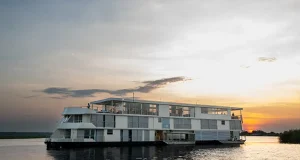Nepal is well known as an exciting trekking and wildlife destination, being recently ranked* number one in the world for ‘nature-connectedness’, and traveller numbers are up as new parts of the country open up to community tourism, which is growing in popularity.
Community Homestay Network (CHN), the pioneer of community-led tourism in Nepal, is growing rapidly, with a rise in traveller numbers of 332 per cent for the 2024 calendar year compared to 2022, demonstrating a huge demand for this people-centric style of travel.
Nepal Tourism Board is also reporting an almost full recovery since the pandemic – 10 years on from the devastating 2015 earthquake of 2015 – with international visitor numbers showing a 98 per cent recovery for travel between January and October, 2025, compared to the same period in 2019.
Two tours recently introduced by CHN are further opening up new parts of both eastern and western Nepal for 2026 travel, with community experiences and local people at the heart of each trip.
The ‘orange city’ of Dhakuta in the east is a vibrant and photogenic local town that sees very few tourists. The new eight-day Eastern Nepal: The Road Less Taken trip starts in Kathmandu, journeys to Dhankuta for an Indigenous Aathpahariya homestay, local market visits and hikes, while supporting sustainability in terms of both culture preservation and water conservation. The trip ends in Janakpur with a hands-on Mithila art session and a visit to Janaki Temple. CHN is also offering a Farm to Table Experience at Kachide in Dhankuta as a separate bookable day activity for travellers not staying in a homestay.
Western Nepal is an emerging destination when it comes to wildlife spotting and CHN is announcing a new tour taking travellers to this lesser-visited part of the country, where the communities of Bhada and Bardiya in western Nepal are home to the Indigenous Tharu people. The nine-day Live the Tharu Way: Journey through Culture, Wildlife and Rural Life trip is available to book now, and as well as wildlife spotting in remote areas, travellers will be hosted by local families at homestays as they are introduced to their way of rural life.
Shiva Dhakal, the founder of Community Homestay Network says that as the new year comes into sight for 2026, community tourism is becoming an even more powerful force.
“This style of community-based travel goes well beyond tourism, simultaneously helping to distribute wealth, to empower women and youth, and safeguard Indigenous traditions and cultures.
“Our two new itineraries provide a solution for immersive travel in emerging eastern and western Nepal at a time where overtourism is a real concern in many parts of the world. Our homestays and standalone artisan day experiences offer visitors a two-way exchange, building meaningful connections between travellers and local people,” says Dhakal.
The two new tour itineraries are available to book now as follows:
- Eastern Nepal: The Road Less Taken – This eight-day adventure starts in Kathmandu, journeys to Dhankuta to visit its ‘orange city’ and Aathpahariya homestays and hikes, and ends in Janakpur with Mithila art and a visit to Janaki Temple, blending nature, culture, and sustainability.
- Live the Tharu Way: Journey through Culture, Wildlife and Rural Life – This nine-day itinerary travels from Kathmandu to Nepal’s vibrant Terai, spending time with the Indigenous Tharu people in Bhada and Bardiya, and going wildlife spotting on a Jeep safari searching for elephants, rhinoceros and the elusive Bengal tiger.
Locally owned and operated, Community Homestay Network – which was this year named one of TIME’s ‘World’s Greatest Places of 2025’ – currently has 50 different experiences available to book. Forty communities in 23 destinations operate community homestays, while 10 communities provide cultural experiences led by local artisans to showcase their culture and traditions.
*Source link: https://www.theguardian.com/environment/2025/nov/01/britain-one-of-least-nature-connected-nations-in-world-with-nepal-the-most





